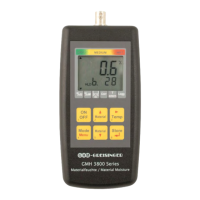H60.0.13.6C-17 Operating Manual GMH 3851 Page 8 of 22
_____________________________________________________ _____________________________________________________________________________
5.6 Measuring in wood: Measuring with two measuring-needles
Normally wood is measured with measuring-needles. Used electrodes: impact-electrode GSE91 or GSG91,
reciprocating piston electrode GHE91. For measuring wood, punch in the measuring-needles across to the wood-grain,
having a good contact between the needles and the wood (measuring along wood-grain deviates minimal)
Select correct wood-sort (refer to Appendix A).
Ensure measuring the correct temperature (see chapter 5.5).
Hint: The special GTF38 temperature-probe can be stuck into a hole punched in with the
electrode before (see picture on left).Now read the measuring-value or when having
activated the auto-hold-function initiate a new measuring by pressing Store/ (button 6) .
The measured resistance will be extremely high when measuring dry wood (<15%) thus
the measuring will need more time to achieve its final value. Among other things static
discharge could momentarily falsify the measuring. Therefore beware of static discharge
and wait long enough until a stable measuring value is displayed (unstable: “%“ blinking)
or use the auto-hold-function (see chapter 5.4 Auto-Hold function).
Most accurate measurements can be carried out within the range of 6 to 30%.
Beyond this range the acquirable accuracy will lessen, but the device will deliver
reference values still sufficient for the practitioner.
Reciprocating piston
electrode GHE91 with
temperature-probe GTF38
It is measured between the measuring-needles insulated among each other. Requirements for an exact measurement:
- choose right correct place to measure: place should be free of irregularities like resin–clusters, knurls, rifts, etc.
- choose correct depth: Recommendation for trimmed timber: punch in the needles up to 1/3 of the material
thickness.
- Perform multiple measurements: the more measurements will be averaged, the more exact the result will be.
- Pay attention to temperature-compensation: the temperature-probe should be measuring the temperature of the
moisture-measuring-place when measuring with external temperature-probe (Atc on).
Without temperature-probe: let the device adapt to the temperature of the wood (Act on) or enter the exact
temperature manually (Act off).
Frequent sources of errors:
- Attention with oven-dried wood: the moisture dispersion may be irregular, often in the core is more moisture than on
the edge.
- Surface-moisture: The wood-edge could be more humid than the core if the wood had been stored outside and e.g.
was in rain.
- Wood preservative and other treatment could falsify the measuring.
- Fouling at the connections and round the needles could result in erroneous measurement, especially with dry wood.
5.7 Split log firewood measuring
For the firewood measuring there is a Average value calculation function integrated. The function calculates the
average value of 3 sequential measuring. Combined with the method described in the following, a reliable measuring of
split logs is possible.
5.7.1 Presetting
Auto Hold on: Automatic measurement
3-Pt on: Average function on
Common firewood specimens can be preset via the “Sort“-Menu, e.g.:
Sor.1 h.460 Spruce
Sor.2 h.206 Pine
Sor.3 h.86 Beech
Sor.4 h.60 Birch
Sor.5 h.401 Group hard wood Beech Birch Oak Ash
Sor.6 h.402 Group soft wood Pine, Spruce Fir
Sor.7 h.461 wood chips with GSF 50 or GSF 50 TF
Sor.8 .ref internal reference, e.g. for monitoring of the precision
Please refer to chapter 4 “Device configuration”.
The specific sort has to be chosen before measuring getroffen werden
5.7.2 Sampling
Choice of representative logs out of stack:
To be able to rate the stack, several logs from different positions should be measured (depending on
position: Top, bottom, weather side...)
The Logs should be free of anomalies like branches, cracks, pitch pockets.
Log size:
The logs to be measured should at least have a width 0f 10 cm and a length of 25 cm.

